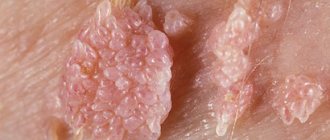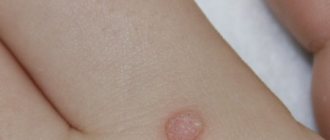The article was prepared by a specialist for informational purposes only. We urge you not to self-medicate. When the first symptoms appear, consult a doctor.
This pathology does not relate to tumors, although the suffix “-oma” (lipoma, hemangioma, myoma), at first glance, assigns it a place in the class of neoplasms. In fact, atheroma is a cyst of the sebaceous glands, formed not due to inflammation, but for completely different reasons.
The most common localization of atheroma on the human body is areas of active sebum production, characterized by an oily sheen. This is the face, the area behind the ears, on the back of the head, between the shoulder blades, on the tailbone.
Why does atheroma occur?
The appearance of a cyst is caused by blockage of the outlet duct of the sebaceous glands. As a result, the sebum produced by the gland does not come to the surface, but accumulates inside. The duct increases in size, and the body’s defense system, trying to stop this process, forms a cyst of connective tissue in the form of a cavity around the atypical formation.
Factors leading to blockage of the sebaceous glands:
- Injury to the epidermis - skin cells, after being damaged by a blunt object, clog the lumen of the sebaceous gland duct.
- Low level of personal hygiene - dust particles and other contaminants must be regularly removed from the surface of the skin so as not to clog the excretory ducts of the glands.
- Hormonal imbalance, the predominance of male hormones - testosterone, dehydroepiandrosterone - leads to changes in the functioning of the sebaceous glands, increased secretion of sebum and its thickening.
- Postmenopause - during menopause, the concentration of estrogen in the female body sharply decreases, which increases the likelihood of changes in the composition of sebum and the formation of atheroma.
Although atheroma most often occurs in adults, the congenital form of this neoplasm is rarely diagnosed in children. The cyst forms in front of the ear and looks like a small ball up to 2 cm in diameter. The cause of atheroma in children is a small defect of the epidermis in the area of the auricle. In the future, such atheroma does not develop and does not affect the child’s health.
Sources of development
Common causes of atheroma formation are presented:
- hereditary predisposition;
- metabolic disorders at the cellular level;
- deviations in hormonal balance - changes in the content of estrogen, testosterone during gestation, menopause, during puberty or against the background of using hormonal drugs over a long period of time;
- stress – psycho-emotional instability leads to active production of sebum;
- increased sweating and violations of personal hygiene rules, the use of decorative cosmetics that cause allergies or other reactions;
- abuse of cosmetic procedures or the use of techniques that aggressively affect the condition of the epidermis;
- pinpoint damage to the sebaceous gland during the removal of acne and pimples;
- violations of the microbial composition of the skin;
- inflammatory processes in the dermis, including acne or rosacea;
- unfavorable influence of the external environment or working conditions.
These sources increase the risk of atheroma formation. The pathological process occurs only with prolonged effects on the dermis and sebaceous glands.
Symptoms of atheroma
Since the formation of atheroma is not accompanied by an inflammatory process, there are no symptoms such as weakness, fever, loss of appetite, hyperemia and changes in the surface layer of the skin. If the atheroma does not become inflamed, then no problems other than a cosmetic defect are recorded.
Location of the cyst:
- Back - most often occurs on the skin between the shoulder blades, although another area of this part of the body is not excluded;
- Head – face, back of the head, area around the ears, chin;
- Crotch;
- Coccyx;
- Armpits;
- Popliteal fossae.
In those areas of the human body in which there are no sebaceous glands (palms, feet), atheromas never form.
Preventive actions
Prevention of atheroma will prevent its reappearance. It is necessary to eliminate the root causes that may lead to its development. It is important to observe the rules of personal hygiene and regularly care for your skin (taking into account its type). It is forbidden to squeeze out pimples and other formations on the skin yourself. It is necessary to monitor hormonal levels, controlling metabolism.
Diet plays an important role in prevention. It is necessary to maintain a balanced diet, since a lack of vitamins and microelements, as well as an excess of fried, spicy and fatty foods, lead to malfunction of the sebaceous glands. If atheromatosis is diagnosed, all unwanted foods and alcohol-containing drinks should be excluded from the daily diet.
Differentiation of atheroma from similar pathologies
A sebaceous cyst may be similar in its symptoms to other subcutaneous formations - an enlarged lymph node, fibroma or lipoma. It is important to know their characteristic features in order to distinguish them from each other. Other formations are so rare that their symptoms are not important for diagnosis.
| Sign | Atheroma | Lipoma | Fibroma | Lymph node |
| Mobility of the skin layer over the formation | Inseparable from the skin, as it is formed in the thickness of its layer | They are located under the skin layer, so the skin is mobile | ||
| Appearance | Looks like a round formation rising above the skin | Often invisible without the use of special equipment or magnification | ||
| Density | Consistency is soft | The consistency is thick | ||
| Soreness | Usually painless, with suppuration there is pain on palpation | The formations are painless | Painful | |
The main signs make it possible to differentiate atheroma from similar pathologies.
Inflammation of atheroma
When pathogenic microorganisms enter the cavity of the cyst, its tissue can become inflamed. The cause of inflammation is injury to the epidermis as a result of cuts, punctures of the skin, scraping of the top layer, attempts to squeeze out atheroma on the face, neck, or back of the head.
Signs of inflammation:
- Increase in size of atheroma by several centimeters in the shortest possible time;
- Hyperemia;
- Swelling;
- Pain on palpation of atheroma.
As a result of inflammation and melting of tissues, pus finds its way out, breaking through the skin. After applying a sterile dressing, you need to contact a surgeon to remove the remaining connective tissue of the capsule and sanitation of the wound.
If you do not consult a doctor and self-medicate, the remaining parts of the capsule will cause the re-formation of atheroma.
How to sign up for the procedure
If you decide to remove the tumor, you can contact an experienced surgeon, Kirill Viktorovich Listratenkov. He has been specializing in surgical interventions using the latest technologies for many years. At the initial appointment, the doctor will conduct an examination, collect anamnesis to identify possible contraindications, and tell you in detail about the procedure. Complete confidentiality and security are guaranteed.
The pricing policy is loyal. Accurate information about the cost can be obtained by contacting the administrator at the specified number. To make an appointment for a consultation, simply leave a request online, indicating the desired date and time. In addition to atheromas, Kirill Viktorovich can remove nevus and a number of other neoplasms.
Surgical treatment of atheroma
The only effective way to treat atheroma is surgical removal, because drug therapy or traditional medicine recipes do not bring any significant results and can cause a relapse.
As soon as signs of inflammation appear around the formation, you should immediately go to the outpatient clinic or the emergency room of a surgical hospital. Uncomplicated atheroma is operated on as planned.
The main goal of surgery is the removal or destruction of the cyst and its contents. Methods of surgical treatment:
| Method | Contents of the method | Advantages |
| Classic method | An incision is made in the superficial layers of the skin, through which the cyst is removed without violating its integrity. A suture is placed on the wound, and then the threads are removed during dressing after healing |
|
| Argon plasma coagulation | Atheroma is destroyed using a beam of plasma at the end of a special scalpel; simultaneously with the destruction of tissue, the blood is stopped |
|
| Laser destruction | The laser knife destroys the cyst and its capsule |
the disadvantage of these methods is their low prevalence due to the high cost of equipment and its absence in public clinics |
| Electrocoagulation | An electric knife removes a cyst using high frequency current | |
| Radio wave knife | Atheroma tissues are burned using high-intensity radio waves |
All surgical methods require local anesthesia. The operation to remove atheroma rarely lasts more than 20 minutes.
Complications
Delaying the treatment of atheroma is fraught with suppuration of the cyst, when its capsule grows in size, swells, turns red, the skin over it becomes tense and causes pain in the patient. Independent attempts to squeeze out the contents of the formation often end with the transition of the disease to a new stage - abscessing atheroma, accompanied by swelling of nearby tissues and lymph nodes, severe pain, and general intoxication of the body. The most unfavorable outcome of the developing situation may be the entry of infection from the purulent sac into the patient’s circulatory system, which can cause sepsis.
If you are looking for where to remove a wen, contact the surgical department of the Miracle Doctor clinic. Experienced surgeons will diagnose and treat using the optimal method.
Make an appointment on the clinic’s website in the “Schedule” section or by calling the hotline.
Postoperative period
In the first days after removal of the capsule, it is important to carefully monitor the condition of the wound. At first, the surgeon performs daily procedures, changing the drainage device and antiseptic dressings. The total duration of the postoperative period is 10-14 days. It takes place on an outpatient basis. Occasionally, complicated forms of atheroma are treated in a surgical hospital.
After the formation of connective tissue between the edges of the wound, the sutures are removed. This manipulation takes no more than 3-5 minutes and is usually painless.
Types of purulent atheromas
The cyst begins to become inflamed in the case of a long course of the disease and occurs in a septic or aseptic way. Inflammation becomes aseptic when the cyst capsule is irritated by the underlying tissues. This is possible when clothing rubs against the formation or puts pressure on it from the outside. The atheroma swells, sometimes pain appears. After a few days, all symptoms subside, and connective tissue forms around the formation. It envelops the atheroma like a shell.
Septic inflammation is recorded more often than aseptic inflammation. The reason is the penetration of infection into the cyst. Symptoms are more clear. Characterized by constant pain in the area of the cyst and redness. Due to the suppuration of the secretion in the atheroma, the local temperature rises, and then the general one. The outcome of such inflammation can be different: from the cyst breaking out or the capsule melting and turning into phlegmon.
What symptoms do you see a surgeon for:
- Presence of hernial protrusion
- Daggering pains in the abdomen
- Bloating
- Pain in the right hypochondrium
- Bitterness in the mouth
- Nausea
- Presence of neoplasms on the skin
- Swelling and redness of the skin
- Bone fractures and bruises
- Wounds of any location
- Vomit
- Enlarged and painful lymph nodes
Dangerous signs of complications after surgery
- Addition of inflammation after removal of an uncomplicated form of the cyst, appearance of pus;
- An increase in temperature indicates tissue infection; normally, hyperthermia disappears within 2-3 days;
- Dehiscence of wound edges – discovered during dressing;
- Leakage of blood through the bandage - increased bleeding is diagnosed in hepatitis, hemophilia, thrombocytopenia, enlarged spleen, as well as in patients using anticoagulants (Aspirin, Cardiomagnyl, Heparin, Thromboass).
The appearance of any of the above signs is a reason to consult a doctor, who will assess the risk of complications and carry out therapeutic measures.
Consultation regarding removal of atheroma
Of great importance when consulting about the removal of atheroma is obtaining reliable information about the possible risks of the operation and the circumstances of the postoperative period. The surgeon learns the presence of concomitant diseases, such as diabetes; taking medications the day before (aspirin, warfarin) that affect the blood coagulation system may be a contraindication to surgery, and the surgeon must be notified of all such circumstances. The consultation also includes an examination, possibly in the dressing room.
Answers to frequently asked questions
- Is there a risk of atheroma reappearing?
Yes, even a small number of surviving cells can give rise to the appearance of a new cyst.
- What does a postoperative scar look like? Is it possible to avoid it?
Minimal scars are formed after surgery using radio wave radiation. In second place is the argon plasma method. After these interventions, there may be no scars at all. Traditional surgery leaves noticeable scars.
- How to prevent atheroma?
There are no specific methods of prevention. It is important to control hormonal levels, maintain hygiene, and avoid skin injury.
- What is the difference between atheroma and lipoma?
Lipoma is located in the thickness of the fatty tissue, it is caused by excessive growth of connective tissue and is a benign tumor.
- Can the process become malignant?
No, such cases are excluded, this is not a precancerous disease.
- Can cyst destruction occur on its own?
No, this is impossible, atheroma cannot resolve, it remains unchanged for a long time.
- Is a surgeon required to operate on non-inflammatory atheroma?
Services under the compulsory medical insurance policy may not provide for the removal of non-inflammatory atheroma. The solution is to undergo surgery in a private clinic or wait for inflammation to develop, which does not guarantee the absence of a cosmetic defect after the intervention.
- What are the consequences of self-squeezing atheroma?
The cyst is usually located in areas of intense blood circulation, so there is a high risk of infection spreading to the brain through the blood vessels if bacteria gets into the wound. You cannot squeeze out the cyst - you need to seek qualified medical help.
Author of the article:
Volkov Dmitry Sergeevich |
Ph.D. surgeon, phlebologist Education: Moscow State Medical and Dental University (1996). In 2003, he received a diploma from the educational and scientific medical center for the administration of the President of the Russian Federation. Our authors











